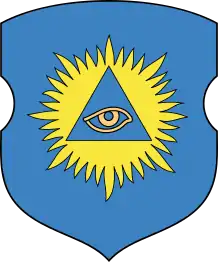Eye of Providence
The Eye of Providence (or the all-seeing eye of God) is a symbol that depicts an eye, often enclosed in a triangle and surrounded by rays of light or Glory, meant to represent divine providence, whereby the eye of God watches over humanity.[1][2][3] A well known example of the Eye of Providence appears on the reverse of the Great Seal of the United States, which is depicted on the United States one-dollar bill.

Use by governments and confederations
United States

In 1782, the Eye of Providence was adopted as part of the symbolism featured on the reverse side of the Great Seal of the United States. It was first proposed as an element of the Great Seal by the first of three design committees in 1776, and is thought to be the suggestion of the artistic consultant, Pierre Eugene du Simitiere.[4]
In his original proposal to the committee, Du Simitiere placed the Eye over shields so as to symbolize each of the original thirteen states of the Union. On the version of the seal that would eventually be approved, the Eye is positioned above an unfinished pyramid of thirteen steps (again symbolizing the original States, but also incorporating the nation's potential for future growth). Such symbolism is explained through the motto that appears above the Eye, annuit cœptis, meaning "He approves [our] undertakings" (or "has approved").[5][6]
Perhaps due to its use in the design of the Great Seal, the Eye has made its way into other American seals and logos, such as, for example:
- The Seal of Colorado
- The city seal of Kenosha, Wisconsin
- DARPA's Information Awareness Office
U.S. currency
The Eye of Providence has been used among various forms currency throughout U.S. history, including:
- the United States one-dollar bill, as part of the Great Seal
- the Vermont Copper
- Nova Constellatio patterns of 1783[7]
- Nova Constellatio coppers of 1783 and 1785[8]
- some Immune Columbia issues[9]
Lithuania
The Eye of Providence appears on several Lithuanian insignia, including:
Other countries

The Eye of Providence appears on the Coat of Arms of Brasłaŭ, Belarus, and of Wilamowice, Poland. The Eye was also part of the flag and coat of arms adopted by the Confederation of the Equator, a short lived 1824 secessionist revolt in the Northeastern provinces of Brazil. In the United Kingdom, the symbol was part of the Guards Division insignia, created in 1915.
In Estonia, the 50 krooni note shows the Eye as part of a depiction of the pipe organ of the Käina church. Likewise, the (old) 500 Ukrainian hryvnia note also depicts the Eye.
The Eye was included in the original publication of France's Declaration of the Rights of Man and of the Citizen, which also borrows iconography from the Ten Commandments. Similarly, the symbol is featured on the front page of the Constitution of Serbia from 1835.
Freemasonry
Today, the Eye of Providence is often associated with Freemasonry, first appearing as part of the standard Freemason iconography in 1797 with the publication of Thomas Smith Webb's Freemasons Monitor.[10][11]
In this use, the Eye, representing the all-seeing eye of God, serves as a reminder that humanity's thoughts and deeds are always observed by God—who is referred to in Masonry as the Great Architect of the Universe. Typically, the Masonic Eye of Providence has a semicircular glory below it, and is sometimes enclosed by a triangle.
Popular among conspiracy theorists is the claim that the Eye of Providence shown atop an unfinished pyramid on the Great Seal of the United States indicates the influence of Freemasonry in the founding of the United States. However, common Masonic use of the Eye dates to 14 years after the creation of the Great Seal. Furthermore, the only Mason among the members of the various design committees for the Great Seal was Benjamin Franklin, whose ideas for the seal were not adopted. Likewise, various Masonic organizations have explicitly denied any connection to the creation of the Seal.[12][13]
Use in religion
Christianity
The association of an eye with the concept of Divine Providence is found in Christianity. In late Renaissance European iconography, the Eye, surrounded by a triangle, was an explicit image of the Christian Trinity.[14] Seventeenth-century depictions of the Eye sometimes show it surrounded by clouds or sunbursts.[15] The Eye of God in a triangle is still used in church architecture and Christian art to symbolize the Trinity and God's omnipresence and divine providence.
The Eye of Providence is notably featured on the following Eastern Orthodox, Mormon, and Catholic buildings, among others:
Eastern religion
The Eye of Providence is a symbol found in Hinduism, particularly throughout the path of Sanātanī dharma, and is the component part of drawing many yantras, which are invoked for various purposes. For example, in the ancient yoga, the symbol is drawn with specific Vedic mantras in order to purify the seat of the yogi.[16]
In Đạo Cao Đài (Caodaism), the Eye of Providence, known as "The Divine Eye," convinces believers that God witnesses everything, everywhere, continuously.
Miscellaneous uses
Commonly in the context of a reference to the Illuminati, numerous video games, TV shows, films, books, and websites contain depictions of the Eye.
University and college insignia
Several universities and college fraternities use the Eye of Providence in their coats of arms, seals, or badges, notably:
- Delta Tau Delta, based in Bethany, West Virginia
- Phi Kappa Psi, based in Canonsburg, Pennsylvania
- Phi Delta Theta, based in Oxford, Ohio.
- Delta Kappa Epsilon, based in New Haven, Connecticut
Gallery
 Alchemical woodcut, which reads quo modo deum ('This is the way of God'), with the All-Seeing Eye floating in the sky
Alchemical woodcut, which reads quo modo deum ('This is the way of God'), with the All-Seeing Eye floating in the sky
 Original seal of the DARPA Information Awareness Office
Original seal of the DARPA Information Awareness Office All-Seeing Eye on the pedestal decorations of Alexander Column
All-Seeing Eye on the pedestal decorations of Alexander Column All-Seeing Eye on the top of the Declaration of Human Rights (1789) from the French Revolution
All-Seeing Eye on the top of the Declaration of Human Rights (1789) from the French Revolution

 All-Seeing Eye on the gate of Aachen Cathedral
All-Seeing Eye on the gate of Aachen Cathedral


 God Eye in West Ukraine (Ukrainian Carpathians) near Mykulychyn village. The inscription on the stone, written in an old Ukrainian dialect, translates to "All will pass but God's eye does not pass you."
God Eye in West Ukraine (Ukrainian Carpathians) near Mykulychyn village. The inscription on the stone, written in an old Ukrainian dialect, translates to "All will pass but God's eye does not pass you." The Eye of Providence, as depicted in Jacopo Pontormo's Supper at Emmaus (1525), in a triangle symbolizing the Christian Trinity; probably added later by Jacopo da Empoli
The Eye of Providence, as depicted in Jacopo Pontormo's Supper at Emmaus (1525), in a triangle symbolizing the Christian Trinity; probably added later by Jacopo da Empoli The Eye of Providence in a Jewish cemetery in Kamienna Góra
The Eye of Providence in a Jewish cemetery in Kamienna Góra Eye of Providence in the canting arms of the Jauch family (motto: "Lord thou shalt guide me with thy counsel", Psalm 73:24)
Eye of Providence in the canting arms of the Jauch family (motto: "Lord thou shalt guide me with thy counsel", Psalm 73:24) All Seeing Eye cross
All Seeing Eye cross
 The Eye of Providence depicted on the "Vistina – La Verite", a medallion issued by the Masonic Lodge in Skopje, Republic of Macedonia.
The Eye of Providence depicted on the "Vistina – La Verite", a medallion issued by the Masonic Lodge in Skopje, Republic of Macedonia.
See also
References
- "The eye as a Christian symbol". catholic-saints.com.
- "The Eye as a religious symbol". Religiousfacts.com.
- "Freemasonry and the All-seeing Eye". Grand Lodge of British Columbia and Yukon.
- Bureau of Public Affairs. July 2003. "The Great Seal of the United States." Washington: U.S. Department of State Archive; See also "Great Seal." Bureau of Public Affairs. 2002. Both retrieved 6 June 2020.
- "Annuit Coeptis - History of Motto Above Great Seal's Eye of Providence". greatseal.com.
- "Thirteen - America's Number On the Great Seal of the United States". greatseal.com.
- Spurrier, Lianna. 7 November 2018. "Lost & Found: The Nova Constellatio Set" (video, 5:40). YouTube.
- "Constellatio Nova Coppers - Introduction". coins.nd.edu. Retrieved 2019-08-09.
- "Immunis Columbia Copper (backdated) 1787: Introduction". coins.nd.edu. Retrieved 2019-08-09.
- Morris, S. Brent. 13 January 2010. "The Eye in the Pyramid." Short Talk Bulletin. Silver Spring, MD: Masonic Service Association. Retrieved 6 June 2020.
- Webb, Thomas Smith. [1791] 1821. The Freemasons Monitor or Illustrations of Masonry. Salem, MA: Cushing and Appleton. p. 66.
- "Anti-masonry Frequently Asked Questions". Grand Lodge of British Columbia and Yukon.
- Barrett, David, W.Bro. "The "Masonic" One Dollar: Fact or Fiction?". Pietre-Stones Review of Freemasonry.
- David Baker (February 21, 2020). "Optical connections: The all-seeing eye". opticianonline.net.
- Potts, Albert M. (1982). The World's Eye. University Press of Kentucky. pp. 68–78. ISBN 978-0-8131-3130-6.
- Saraswati, Satyananda, and Vittalananda Saraswati. [1998] 2015. Siva Puja and Advanced Yajna. Temple of the Divine Mother, Inc. ISBN 9781887472623. p. 21.
External links
 Media related to Eye of Providence at Wikimedia Commons
Media related to Eye of Providence at Wikimedia Commons

